Mitsubishi Mirage
The Mitsubishi Mirage is a range of cars produced by the Japanese manufacturer Mitsubishi from 1978 to 2003 and again since 2012. The hatchback models produced between 1978 and 2003 were classified as subcompact cars, while the sedan and station wagon models, marketed prominently as the Mitsubishi Lancer, were the compact offerings. The liftback introduced in 1988 complemented the sedan as an additional compact offering, and the coupé of 1991 fitted in with the subcompact range. The current Mirage model is a subcompact hatchback and sedan and it replaces the Mitsubishi Colt sold between 2002 and 2012.
| Mitsubishi Mirage | |
|---|---|
.jpg) | |
| Overview | |
| Manufacturer | Mitsubishi Motors |
| Production | 1978–2003 2012–present |
| Body and chassis | |
| Class | Subcompact car (B) (1978–1995, 2012–present) Compact car (C) (1995–2003) |
| Body style | 4-door sedan 3/5-door hatchback 5-door station wagon |
| Layout | Front-engine, front-wheel-drive (1978–2003, 2012–present) Front-engine, all-wheel-drive (1983–2003) |
Nameplate history
The Mirage has a complicated marketing history, with a varied and much convoluted naming convention that differed substantially depending on the market. Mitsubishi used the Mirage name for all five generations in Japan, with all but the first series badged as such in the United States. However, other markets often utilized the name Mitsubishi Colt and sedan variants of the Mirage have been widely sold as the Mitsubishi Lancer—including in Japan where the two retailed alongside one another. In Japan, the Mirage was sold at a specific retail chain called Car Plaza.
In the United States and Canada, the first four generations were sold through a venture with Chrysler as the Dodge Colt and the similar Plymouth-badged Champ and Colt. Later, the venture brought the Eagle Vista and Summit branded models which sold alongside the aforementioned. Confusingly, Chrysler has also offered an unrelated Dodge Lancer at various stages between the 1950s and 1980s. However, when DaimlerChrysler briefly controlled Mitsubishi through the DaimlerChrysler-Mitsubishi alliance from 2000 through to 2004, the license to the "Lancer" name was relinquished to Mitsubishi for usage in North America. Thus, after the fifth and final generation Mirage, replacement models in North America have adopted the new name.
Mitsubishi introduced replacements for the fifth series of Mirage, starting in 2000 with a new generation of Lancer—now larger, having moved up to the compact segment. Then in 2002, a subcompact five-door hatchback badged Colt globally became available. By 2003, the Mirage and its derivatives had been completely phased out of mainstream Japanese production. For the 2002-era Colt's replacement in 2012, Mitsubishi decided to resurrect the Mirage name internationally for a new sixth generation model.
With the rising popularity of boxy subcompact SUVs in Japan, the Mirage nameplate was used on a domestic market-only model called the Mirage Dingo, from 1999. The Dingo was facelifted in 2001 and canceled in 2003. However, New Zealand sold a very different Mirage from 2002—a rebadged Dutch-manufactured Mitsubishi Space Star labeled Mirage Space Star. This vehicle was not very popular and was discontinued in 2003.
First generation (1978)
| First generation | |
|---|---|
_GLX_5-door_hatchback_(2009-09-04)_01.jpg) Pre-facelift Mitsubishi Colt 5-door (Australia) | |
| Overview | |
| Also called |
|
| Production | March 1978 – October 1983 (Japan) 1982–1989 (Australia) |
| Assembly | Japan: Okazaki (Nagoya Plant) Australia: Clovelly Park New Zealand: Todd Park |
| Body and chassis | |
| Body style | 3-door hatchback 4-door sedan 5-door hatchback |
| Layout | Front-engine, front-wheel-drive |
| Related | |
| Powertrain | |
| Engine | |
| Transmission | 4-speed manual (Super Shift) 5-speed manual 3-speed automatic |
| Dimensions | |
| Wheelbase | 2,300 mm (90.6 in) (3-door) 2,380 mm (93.7 in) (4- and 5-door) |
| Length |
|
| Width | 1,585 mm (62.4 in) |
| Height | 1,350 mm (53.1 in) |
| Curb weight | 900 kg (1,984 lb) |
Mitsubishi launched the Mirage as a front-wheel drive three-door hatchback in March 1978, as a response to the 1973 oil crisis. A five-door hatchback on a longer wheelbase arrived in September. Since most overseas markets did not have the Minica kei car, the Mirage was usually sold as Mitsubishi's entry-level model. Chassis codes were from A151 to 153 for the three-doors, with A155 and up used for the longer five-door version.[2]

_SE_sedan_(24187480105).jpg)
_XL_5-door_hatchback_(14976570289).jpg)
Mirage featured four-wheel independent suspension, rack and pinion steering, plus front disc brakes.[3] Power initially came from 1,244 and 1410 cc iterations of the familiar Orion engine, putting out 72 and 82 PS (53 and 60 kW), respectively.[4] Of particular note, the 1410 cc variant featured "modulated displacement"—a system that could shut down cylinders under cruising or idle conditions to reduce fuel consumption.[5] Mitsubishi added the moderately more powerful 1.6-liter Saturn engine to the range in March 1979, for the 88 PS (65 kW) 1600 GT model.[6]
The Mirage also debuted Mitsubishi's Super Shift transmission, a four-speed manual with a second lever for "low" and "high" range; effectively making the transmission an eight-speed unit.[7] The Super Shift was not originally planned. However, Mitsubishi engineers had to make use of the existing Orion engine designed for rear-wheel drive applications making use of the longitudinal engine orientation. In the Mirage, sizing constraints as a result of the front-wheel drive layout required the engine to be mounted transversely, thus causing the carburetor to face forwards and run into icing issues.[8] However, the primary implication of the Mirage's powertrain orientation — and the issue that demanded the unconventional transmission — was the mounting of the transmission beneath the engine. This required the gearbox to take power down from the clutch, an action not possible directly as this would have dictated that the gearbox rotate in the opposite direction to that required. To overcome this, the use of an extra "idle" transfer shaft was necessitated.[7] It was subsequently realized that for a cost no more than developing a new five-speed transmission,[8] this shaft could be modified as a separate two-speed gearbox controlled by a secondary shift lever mounted alongside the main lever inside the cabin. The ratios on this transfer transmission were, in effect, "underdrives"—consequently marked on the second shift lever as a "power" mode due to increased performance granted by the lower gearing. In contrast, the higher overdrive setting was noted as "economy".[7] Mitsubishi called this a unique selling proposition.
Facelift
In February 1982, Mitsubishi facelifted the Mirage range. Distinguished by the installation of flusher fitting headlamps that extended into the fender panels, stylists also designed a new grille insert. The taillights were larger, new firmer engine and transmission mounts were fitted, and a new, lighter and more rigid transmission case was developed.[9] The dashboard was also updated, with rotating "satellite" buttons mounted within fingertip reach for light and wiper functions.[10] Another new version for the Japanese market was the 1600SX, a well-equipped five-door automatic fitted with the 1600GT's 88-PS engine.[11]
At the same time as this facelift, Mitsubishi introduced a four-door sedan variant to Japan under the names Mirage Saloon and Lancer Fiore, which is not to be confused with the unrelated regular Lancer.[5] The Fiore was often abbreviated to Lancer or Lancer F in international markets, eschewing the "Fiore" suffix.[12] The sedan's backseat folded in a 60/40 split, just as for the hatchback.[13] With Mirage hatchback and sedan sales in Japan restricted to the Car Plaza dealerships, the Fiore was intended to duplicate the Mirage's success at the Galant Shop — Mitsubishi's second retail sales channel. Lancer Fiore received the same 1.2- and 1.4-liter engines, and as a Mirage-derived model line, was substantially smaller than the strict Lancer. Apart from the wider axle track dictated by the switch to front-wheel drive, the original 1973-era Lancer offered a similar dimensional footprint.[5] Unique to the four-door saloons was Mitsubishi's new "Modulated Displacement" (MD) engine, a short-lived technology which allowed the engine to run on only two cylinders while under light loads so as to save on petrol.
A more sporting turbocharged 105 PS (77 kW) version of the 1.4-liter engine was made available in Japan from the time of the facelift as the 1400 GT Turbo, originally only in the three-door hatchback.[14] To handle the additional power, the suspension was made firmer, the brake servo was upgraded, and the driveshaft was changed to an equal-length design featuring a central bearing.[15] The small turbocharger, of Mitsubishi's own manufacture, unusually sat between the intake and the twin-barrel carburetor. The engine was equipped with a knock sensor, enabling it to run on petrols of various octane ratings. The compression ratio was also unusual, fairly high for its time at 8.7 to 1.[16] The Turbo also used the twin-range Super Shift transmission. In Japan, the Turbo was also available with the five-door hatchback bodywork, a version that was rarely exported (if at all).[11] Japanese buyers could also opt for the new turbocharged Lancer Fiore/Mirage Saloon 1400GT; all three of these turbo versions arrived in August 1982.[17] Mitsubishi distinguished the 1400GT with a hood mounted air intake, unique interior, uprated suspension and brakes, and the equalization of the drive shaft lengths to reduce torque steering.
In October 1982 the 1200EX Special (hatchbacks) and 1200EL Special (saloons) were launched in Japan; these were well equipped low-cost versions with heated rear windshields and other extras.[18] The 1400MD Super and Marie limited editions were launched in December 1982.[19] Japanese manufacture of all body variants ended in October 1983.
North America
Chrysler imported this generation of Mirage to the North America as the Dodge Colt and Plymouth Champ from late-1978 for the 1979 model year,[3] in three-door form only until the 1982 model year when the five-door was added.[20] Then from the 1983 model year, Plymouth retired the Champ and adopted the name Colt as well. 0-60 time was over 12 seconds, and the top speed was 90 MPH.[21]
Australia and New Zealand
The facelifted model was also manufactured as the Colt by Mitsubishi Motors Australia[7] at their Clovelly Park, South Australia plant from 1982[22] to late 1989, with sufficient inventory stockpiled not exhausting until 1990.[23] Initially offered with the 1.4- and 1.6-liter engines in five-door hatchback form, the sedan was produced from 1984.
Australian Colts were given model codes RA (from November 1980), RB (October 1982), RC (April 1984), RD (October 1986),[24] and RE (September 1988). The RE update was distinguished by revised wheel covers, body side projection mouldings, and grille, plus the addition of body colour bumpers.[25] The SE model was dropped, with the range opening up with the fleet-focused XL hatchback with the 1.4-litre engine and a four-speed manual gearbox, stepping up to the 1.6-litre, GLX hatchback and sedan with five-speed manual or optional three-speed automatic.[25]
This model was also briefly exported to New Zealand in the late 1980s, where it shared showroom space with the locally assembled third generation models. Previously, local complete knock down (CKD) assembly of the Colt took place in Petone, Wellington under contract through Todd Motor Corporation (the NZ, Mitsubishi assembly franchise holders), including a variant called the Mirage Panther.
Europe
Many export markets, such as Europe and Australia received the Mirage under the Colt name. In the United Kingdom, where Colt was the marque itself, it was called the Colt 1200 and Colt 1400, after the engine displacements. In most of Europe, it was sold as the Mitsubishi Colt. The Lancer Fiore (sometimes called Lancer F) arrived in early 1983, which is also when the facelift appeared in Europe.[9] European market models usually have the 1200 or the 1400 engine, with 55 or 70 PS (40 or 51 kW) on tap. Max power was reached at 5000 rather than 5500 rpm for the Japanese market models, and they were fitted with somewhat gentler cams for a less peaky power delivery.[26] Some European markets also received the 105 PS (77 kW) Turbo model, which arrived in late 1982. After the introduction of the second generation Mirage/Colt, the original model remained available in Belgium (at least) as the "Mitsubishi Magnum", only offered as a three-door with the smallest engine and bare-bones equipment.
Second generation (1983)
| Second generation | |
|---|---|
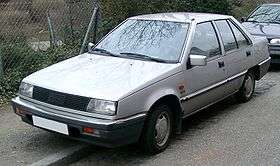 | |
| Overview | |
| Also called |
|
| Production |
|
| Assembly | Japan: Okazaki (Nagoya Plant) Thailand: Laem Chabang (MMTh) Indonesia: Pademangan, North Jakarta (PT. Krama Yudha Kesuma Motor) New Zealand |
| Body and chassis | |
| Body style | 3/5-door hatchback 4-door sedan 5-door station wagon 5-door panel van |
| Layout | Front-engine, front-wheel-drive Front-engine, four-wheel-drive |
| Related | Dodge / Plymouth Colt Eagle Vista Proton Saga |
| Powertrain | |
| Engine | |
| Dimensions | |
| Wheelbase | 2,380 mm (93.7 in) |
| Length | 4,005 mm (157.7 in) |
| Width | 1,635 mm (64.4 in) |
| Height | 1,360 mm (53.5 in) |
| Curb weight | 880 kg (1,940 lb) |
Mitsubishi launched the second generation Mirage to Japan in 1983, again splitting the range into Mirage (three- and five-door hatchback, plus four-door sedan) and Lancer Fiore (four-door sedan) models. A station wagon version of the Mirage was added in 1985, with a four-wheel drive wagon available from the fall of 1986 with the 1.8-liter gasoline engine.[28] Many export markets sold the hatchbacks as Mirage or Colt, with the sedan and wagon commonly badged Lancer. This wagon model went on to become very popular in both the commercial and private sectors overseas as well as in Japan. C10-series chassis numbers denote front-wheel-drive models, while C30-series numbers are for four-wheel-drive versions (only station wagons).
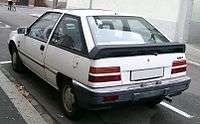
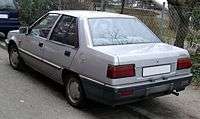
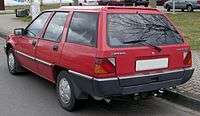
Uprated engines were deployed into the series; 1.3- and 1.5-liter Orion gasoline engines replaced the previous 1.2- and 1.4-liter Orion units. Mitsubishi also released variants fitted with the 1.6 and 1.8-liter Sirius gasoline powerplants, and for the first time a 1.8-liter Sirius diesel was added. The 1.6-liter Sirius engine also included a turbocharged variant with between 105 PS (77 kW) and 125 PS (92 kW), featuring the latest in computer control engine technology including electronic fuel injection.[27] Power differed for cars with catalyzers, or for markets with lower octane fuel. Some European markets received a smaller 1.2-liter "tax special" as well, with 55 PS (40 kW).[29]
The car received a very mild facelift in early 1986, along with some new engine options for the Japanese domestic market. This included a fuel-injected version of a new 1.5-liter engine from the Saturn family, the G31B. The transmissions were updated at the same time.[28] The second generation Mirage hatchback was replaced in October 1987; the sedans were replaced in January 1988.
The Wagon and Van versions were kept in production with some minor updates until 1991, as there was no station wagon of the third generation Mirage and Lancer. The diesel engine remained the 1.8-liter 4D65 (also available with four-wheel drive) while the petrol 4G13 and 4G15 were updated with the same new twelve-valve heads as were used on the third generation Mirage beginning in 1989. Power outputs climbed by 12 horsepower for both petrol versions, to 79 and 85 PS (58 and 63 kW) in Japanese trim.[30]
Export
- Europe
The Mirage was available in Europe as the Colt in 1200 L, EL, and GL trims (mostly three-door models only, but a five-door GL was sold in some markets[31]), as the 1300 GL three- and five-door, 1500 GLX three- and five-door, and as the 1800 L/EL/GL (diesel) three- or five-door. The Lancer sedan was available in the same trim levels as the hatchback model (including the 1200 engine), while the wagon versions were available as 1500 GLX and 1800 GL diesel only. The three-door Colt Turbo was also sold in Europe, with the 125 PS (92 kW) 1.6-liter ECI engine.[32] The Colt Turbo fared badly in competition with its European GTi-class competitors, with period testers criticizing Mitsubishi for not doing much more than adding a turbocharger, spoilers, and fat tires. It was not a thorough engineering job and the car was not able to fully handle the ample power made available.[33]
Some markets also received the 4WD Wagon with the larger 1.8 engine, although the diesel-powered 4WD remained available to Japanese customers only. Versions equipped with catalytic converters first became available in Europe in 1985, at the same time as the wagon was introduced.[28] The two-seater commercial type was sold in the Netherlands simply as the "Mitsubishi Wagon", whereas the better equipped passenger version was called the Lancer Station Wagon.[29]
- North America
The Mirage was not sold in the United States by Mitsubishi until 1985. Mitsubishi licensed the "Mirage" name from Grand Touring Cars, Inc. of Scottsdale, Arizona for use in the United States, as they already owned the rights to the name with the Mirage race car series. Dodge/Plymouth Colt-branded models initially came in three-door E, DL and RS Turbo models, four-door DL, and Premier (the latter with the base or turbo engine) and five-door E, with a DL five-door offered in Canada; an E sedan replaced the five-door for 1986, and the wagon (in DL trim only but with an all-wheel drive option) joined the line for 1987. Curiously, Mitsubishi marketed the Mirage only as a three-door hatch through its own American dealers despite the five-door model having repeatedly been rejected in favor of the Dodge Omni by Chrysler's marketing organization.
- New Zealand
A commercial version of the wagon was sold in New Zealand as the Mitsubishi Express, replacing an earlier model based on the Galant Sigma. The Mirage range was also assembled in New Zealand, but was never sold in Australia, where the original version was kept in production until the next generation replaced it in 1988.
- Southeast Asia
Mitsubishi in Thailand released the three-door and sedan models with 1.3- and 1.5-liter engine as the Mitsubishi Champ in 1983. Later the series was renamed Mitsubishi Champ II and Champ III, with the hatchback and 1.5-liter versions discontinued. The Champ was retired in 1994. In Indonesia, all models (including the hatchback) were sold under the Lancer nameplate.
The four-door sedan formed the basis of the Proton Saga, Malaysia's first locally built car and manufactured between 1985 and 2008. Proton would later spin the Saga off into its own five-door hatchback called the Saga Aeroback in 1987 (longer, and styled differently from Mitsubishi's own five-door hatchback version).
Third generation (1987)
| Third generation | |
|---|---|
_SE_sedan_(2011-04-22)_02.jpg) Pre-facelift Mitsubishi Lancer sedan (Australia) | |
| Overview | |
| Also called | |
| Production | 1987–1995 (hatchback) 1988–1995 (sedan) 1988–1996 (liftback) |
| Assembly | Japan: Okazaki (Nagoya Plant) New Zealand Indonesia: Pademangan, North Jakarta (PT. Krama Yudha Kesuma Motor) Philippines: Cainta (MMPC) Thailand: Laem Chabang (MMTh) United States: Normal, IL (DSM) |
| Body and chassis | |
| Body style | 3-door hatchback 4-door sedan 5-door liftback |
| Layout | Front-engine, front-wheel-drive Front-engine, four-wheel-drive |
| Related | Dodge / Plymouth Colt Eagle Summit |
| Powertrain | |
| Engine | |
| Transmission | 4/5-speed manual 3-speed automatic |
| Dimensions | |
| Wheelbase | 2,385 mm (93.9 in) (3-door) 2,455 mm (96.7 in) (sedan) |
| Length | 4,030 mm (158.7 in) (3-door) 4,320 mm (170.1 in) (sedan) |
| Width | 1,670 mm (65.7 in) |
| Height | 1,320 mm (52.0 in) (3-door) 1,340 mm (52.8 in) (sedan) |
Mitsubishi introduced the more rounded, third-generation Mirage to Japan in October 1987. Masaru Furukawa headed the vehicle design, with Yasukichi Akamatsu given the role of chief engineer. The basic model, a three-door hatchback with upright tailgate and large glasshouse arrived first. The sedan, released to Japan in January 1988 was stylistically distinct with almost vertical rear glass, influenced by the larger Galant. The range was complemented by a five-door liftback in June 1988, but without a station wagon variant, Mitsubishi persevered with the previous model until the release of a new wagon on the fourth generation chassis. As before, Mirage, Colt, and Lancer naming varied between markets with different body shapes often having different titles in the same market. In Japan, sedans were available with the Mirage and Lancer nameplates, while the three-door was sold only as Mirage, and the liftback only as Lancer. Japanese Mirage sedans usually featured the "Vie Saloon" suffix.
_GSR_3-door_hatchback_(2015-07-10)_02.jpg)
_SE_sedan_(2011-04-22)_04.jpg)
_GLX_5-door_hatchback_(2015-07-14)_01.jpg)
_GLX_5-door_hatchback_(2015-07-14)_02.jpg)
Engines available were 1.3- and 1.5-liter Orion gasoline inline-fours, plus 1.6 and 1.8-liter Saturn gasoline inline-fours. For Greece only, a 1.2-liter version of Orion engine available in the entry-level models outputted 48 kW (65 PS).[34] The 1.8-liter Sirius diesel carried over from the previous shape. In Japan, four-wheel-drive versions were also available, fitted with the carbureted 1.5 and fuel-injected 1.6-liter gasoline engines, or 1.8-liter diesel. The top Mirages in Japan were called the "Cyborg", featuring the turbocharged 1.6-liter motor developing 107 kW (145 PS) — the same unit as fitted to the GSR sedan.
The third generation received a minor facelift in September 1989, with late models receiving the same modernized engines as were seen in the subsequent generation.[35] In its most potent turbocharged variant, the new 4G61 engine produced 160 PS (118 kW) at 6000 rpm.[36]
European versions were available as the 1300 GL, 1500 GLX, 1600 GTi, and 1800 GTi 16v (from 1989), with the three-door labelled Colt and the sedan and liftback called Lancer. Mitsubishi retailed a Colt "van" in select European markets, being the three-door body without rear side windows and therefore attracting reduced taxation in these jurisdictions.
Since first generation Mirages were still under Australian production as the Colt, all three third generation body types were sold under the Lancer name in that market. Initially, the Australian-specification models were designated as the CA series when introduced in 1988, adopting the CB designation for the 1990 facelift. The liftback continued to be sold in Australia alongside the fourth generation (CC) Mirage-derived Lancer from 1992 through to 1996. Confusingly, the carry-over liftback was also given this CC model designation.[37][38]
North American three-door and sedan sales occurred under the Mitsubishi Mirage name for the 1989 to 1992 model years. Badge engineered variants were also sold in the US as the Dodge/Plymouth Colt (three-door only), and Eagle Summit. In Canada, a Dodge/Plymouth sedan was also offered as the Mitsubishi brand did not operate in the market until the 2003 model year. For the Mitsubishi-badged versions, the top hatchback carried a 1.6-liter 4G61T turbocharged inline-four engine rated as 135 hp (101 kW). For the 1991 model year, the 1.5-liter 4G15 engine's new twelve valve heads (three valves per cylinder) boosted power from 81 to 92 hp (60 to 69 kW), and a new GS sedan offered the 1.6-liter 4G61 with 123 hp (92 kW) and a standard four-speed automatic transmission.
Fourth generation (1991)
| Fourth generation | |
|---|---|
_GLXi_coupe_01.jpg) Mitsubishi Lancer coupé (Australia) | |
| Overview | |
| Also called |
|
| Production | October 1991–1995 1992–2012 (wagon) |
| Assembly |
|
| Body and chassis | |
| Body style | 2-door coupé 3-door hatchback 4-door sedan (four-window) 4-door sedan (six-window) 5-door station wagon |
| Layout | Front-engine, front-wheel-drive Front-engine, four-wheel-drive |
| Related | Mitsubishi Lancer Evolution Dodge / Plymouth Colt Eagle Summit Proton Arena / Putra / Satria / Wira |
| Powertrain | |
| Engine | |
| Transmission |
|
| Dimensions | |
| Wheelbase | 2,440 mm (96.1 in) (coupé) 2,500 mm (98.4 in) (sedan) |
| Length | 4,345 mm (171.1 in) (coupé) 4,375 mm (172.2 in) (sedan) |
| Width | 1,680 mm (66.1 in) (coupé) 1,690 mm (66.5 in) (sedan) |
| Height | 1,310 mm (51.6 in) (coupé) 1,325 mm (52.2 in) (sedan) |
In October 1991, the fourth generation Mirage made its debut for the Japanese market alongside the related Lancer. Departing from the previous series, the new Mirage adopted a much rounder body shape—a change duplicated by much of the automotive industry in the early-1990s. As before, the Japanese Mirage lineup comprised the three-door hatchback (now called Mirage Cyborg) and sedan (now with a six-window glasshouse), plus a new coupé body type suffixed Asti. Lancer variants sold in Japan offered unique body variants—a four-windowed sedan and from May 1992, a station wagon simply named Mitsubishi Libero. In most markets the wagon's introduction coincided with a small update for 1993, with new bumpers and adjustments to the engine lineup.[39] The Lancer wagon was sold until 2003 in the Australian and New Zealand markets, primarily for fleet buyers. The wagon was still sold as of 2012 in Belize,[40] however as of 2013 the model is no longer offered on the website.[41]
_Executive_sedan_01.jpg)
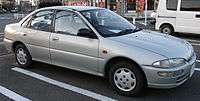
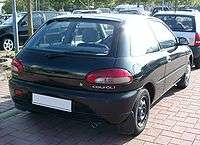
_GLXi_coupe_02.jpg)
_GLi_station_wagon_(16334139503).jpg)
.jpg)
Unlike prior generations, the Japanese market Lancer range co-existed with greater differentiation when compared to the Mirage. The Mirage with its sportier appearance and tapered hood, featured elliptical headlamps with a very narrow single-port grille. Lancer variants diverged with more angular styling characterized by the more upright design. The Lancer also featured re-shaped fenders, less rounded headlamps, and a larger dual-port grille. Although both were built on the same platform, the Japanese-specification Lancer sedan received different sheet metal than the Mirage equivalent. More traditional in silhouette, the Lancer sedan (suffixed Vie Saloon) featured a simple four-window glasshouse, whereas the Mirage sedan adopted a more modern six-window glasshouse with abbreviated trunk.
Naming of the various models for export was many and varied. As a Mitsubishi, the three-door was restricted to the Mirage and Colt names, but the Mirage Asti coupé was often badged Lancer as well. With the sedan, export markets only retailed the four-window variation, although this occurred under both the Lancer and Mirage names.
Mitsubishi's powertrain choices were vast with this new platform. Front-wheel drive was most common, with all-wheel drive available for some models. Engines ranged from 1.3- to 1.8-liter naturally-aspirated gasoline inline-fours, 1.8 and 2.0-liter turbocharged versions of the same, plus 1.8 and 2.0-liter diesels. Notably, a gasoline V6 engine variant was also offered, displacing just 1.6-liters, making it the smallest mass-produced V6. The 1.8-liter turbocharged inline-four, producing 145 kW (197 PS), was sold as a "Lancer GSR" and from September 1993, formed the basis of the Lancer Evolution I that used the 2.0-liter 4G63 engine from the successful Galant VR-4 rally car. An electric version of the wagon was released to Japan named the "Lancer Libero EV" and utilizing a nickel–cadmium battery.
Australian market versions of this generation were released in late 1992 and were officially referred to as the CC series Lancer.[42] Buyers had the choice of the Lancer coupé (available in GL and GLXi equipment levels), sedan (GL, Executive, and GSR), and wagon (Executive). Five-speed manual transmission came fitted as standard, with all variants except the GSR available with automatic—three gears for the base coupé and sedan—and a four-speed unit for the remainder of the lineup. The GL coupé and sedan featured the 1.5-liter carbureted motor, with the 1.8-liter fuel-injected engine reserved for the rest of the series. All engines except in the GSR are single overhead camshaft design; the GSR featured double overhead camshafts, plus a turbocharger and intercooler.[42]
This model launched in the United States for the 1993 model year as the Mirage, with all variants now sourced from Japan (instead of Japan or Illinois as previously). The same body shapes were also sold as the Dodge and Plymouth Colt in both the United States and Canada. The six-window greenhouse sedan was sold in these countries as the Eagle Summit alongside a coupé of the same name. For the Mitsubishi branded versions sold only in the United States, the coupé and four-window sedan were offered in base, S, ES and LS trim levels. Five-speed manual transmission was standard, although an automatic was optional on all Mirages except the S coupé. Mitsubishi kept the preceding generation's base 1.5-liter 4G15 engine with 92 hp (69 kW), but fitted the ES and LS sedans with the new 1.8-liter 4G93 engine rated at 113 hp (84 kW). For the 1994 model year, Mitsubishi introduced a driver's airbag, the LS sedan lost its optional anti-lock brakes, and the LS coupé gained the 1.8-liter engine previously exclusive to sedans. The 1994 model year was the last year of retail sales for Mirage sedans (which became limited to fleets) and for the Dodge and Plymouth Colts altogether, although the Eagle Summit sedan and coupé remained on sale alongside the Mirage coupé through to 1996. As a consequence, only S and LS Mirage coupés returned for model year 1995, and both benefitted from a new passenger's side airbag and covered center console (and therefore the deletion of the motorized front seatbelts). The 1995 Mirage LS coupé gained uprated 14-inch wheels, but deleted access to power windows, power door locks, and cruise control.
Mitsubishi granted Proton in Malaysia a license to the fourth generation design from 1993—and remained in produced in a distant form until 2010. The first variant produced, the sedan was badged Proton Wira (1993–2007) and was complemented by a Proton-designed five-door Wira hatchback (1993–2004). Malaysian manufacture of other variants commenced later, with the three-door Satria (1995–2005) and Putra coupé (1995–2000; and 2004–2005). Proton then developed a coupé utility variant which came to fruition in 2002 as the Arena, lasting until 2010.
Fifth generation (1995)
| Fifth generation | |
|---|---|
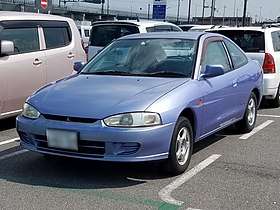 Mitsubishi Mirage Asti (coupé) | |
| Overview | |
| Also called |
|
| Production | 1995–2003 (Japan) 1998–2012 (India)[43][44] 2003–2019 (China) 2004–2010 (Venezuela)[45][46] |
| Assembly | Japan: Okazaki (Nagoya Plant) China: Fuzhou (Soueast) India: Tiruvallur (Hindustan) Taiwan: Yangmei (China Motor) Thailand: Laem Chabang (MMTh) Indonesia: Pademangan, North Jakarta (PT. Krama Yudha Kesuma Motor) Philippines: Cainta (MMPC) United States: Normal, IL (DSM) Venezuela: Barcelona (MMC Automotriz) |
| Body and chassis | |
| Body style | 2-door coupé 3-door hatchback 4-door sedan |
| Layout | Front-engine, front-wheel-drive Front-engine, four-wheel-drive |
| Related | Mitsubishi Lancer Evolution |
| Powertrain | |
| Engine | |
| Transmission | 5-speed manual 4-speed automatic CVT (China) 5-speed INVECS-II Sport Tronic semi auto (Thailand)(China) |
| Dimensions | |
| Wheelbase | 2,415 mm (95.1 in) (hatchback) 2,500 mm (98.4 in) (sedan) |
| Length | 3,900 mm (153.5 in) (hatchback) 4,270 mm (168.1 in) (coupé) 4,410 mm (173.6 in) (sedan) 4,430 mm (174.4 in) (Soueast Lioncel) 4,400 mm (173.2 in) (Mitsubishi Lancer) 4,420 mm (174.0 in) (Soueast Lingyue) |
| Width | 1,680 mm (66.1 in) (hatchback) 1,690 mm (66.5 in) (sedan) 1,700 mm (66.9 in) |
| Height | 1,365 mm (53.7 in) (hatchback) 1,305–1,360 mm (51.4–53.5 in) (coupé) 1,335–1,390 mm (52.6–54.7 in) (sedan) 1,410 mm (55.5 in) (Soueast Lioncel) 1,415 mm (55.7 in) (Mitsubishi Lancer and Lingyue) |
| Curb weight | 945 kg (2,083 lb) (three-door) 1,105–1,150 kg (2,436–2,535 lb) (Soueast Lingyue) |
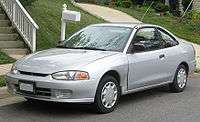
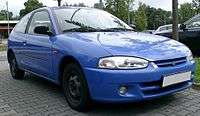
.jpg)
_3-door_hatchback_(2016-01-04)_02.jpg)
_GLXi_sedan_(2009-12-20).jpg)
_GLi_sedan_(2015-07-14)_02.jpg)
_GLXi_sedan_(2009-09-17)_02.jpg)
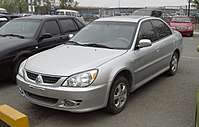
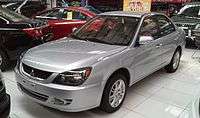
The release of the fifth generation Mirage to Japan in October 1995 introduced a rationalized lineup as a result of the fragile post-bubble economy in Japan. Three body types were issued: first, the three-door hatchback and sedan, then in December 1995, the two-door coupé (Asti). While the sedan grew slightly in size, the coupé shrunk modestly. It was bumped from the subcompact class to compact in the United States. Whereas the previous Mirage sedan sold in Japan featured a six-window profile, the 1995 redesign shared its styling with the Lancer except for minor differences in trim. For the Lancer, these included a different trunk lid, amber front turn signal lamps, and a restyled grille garnish. No station wagon of this generation was offered, although the previous generation wagon continued over the entire fifth generation production run. While only the sedan formed part of the Lancer range in Japan, both the coupé and sedan were labeled as Mirage and Lancer in export markets. Between 1995 and 2004, the Mitsubishi Carisma supplanted the sedan in some European markets.
A minor facelift arrived in 1997. Of note, the Lancer sedan featured a new grille and reshaped inner-portions of the headlamps to better differentiate it from the Mirage donor model. Both the coupé and sedan benefited from redesigned taillamps, whereas the three-door only received a redesigned front bumper incorporating a larger grille. In 1997, a classically styled version of the Mirage three-door hatchback became available in Japan, badged Mirage Modarc. The Modarc featured chrome for the grille, side mirrors, door handles, and bumper strips; it also included fog lights and optional alloy wheels. In 2001, the Mirage-based models gained a chrome-trimmed grille insert in limited markets.
Although a new, substantially larger and more expensive generation of Lancer sedan arrived in 2000, many export markets retained the Mirage-derived model up until 2003 when Japanese manufacture concluded and Mitsubishi retired the "Mirage" nameplate worldwide. This is especially true of the hatchback and coupé which were not redesigned due to Mitsubishi's financial troubles. In other markets, the newer sedan often co-existed with the old as a more premium offering. Mitsubishi eventually replaced the three-door in 2005 for Europe only with the three-door Colt—the name previously used in many export markets to denote the Mirage from 1978 onwards. A five-door variant of the Colt had earlier been released in 2002. By 2003, the only Mirage sold in Japan was the coupé, now without the Asti designation. Mitsubishi did not tender a replacement for the coupé.
European three-door CJO series models of this generation were sold between 1995 and 2001 as the Colt. Sedans and wagons sold as Lancers.
In the United States, the fifth generation Mirage arrived for the 1997 model year and was again available in sedan and coupé versions. The 1.5- 4G15 and 1.8-liter engines from the previous iteration returned in DE and LS trims, respectively. The 1998 model year brought a stronger starter and battery; 1999 introduced a minor facelift, plainer seat fabric; and for the LS coupé, white-faced gauges and a tachometer with either transmission (it was formerly exclusive to the manual). For 2000, Mitsubishi added further standard equipment, plus the standardization of the 1.8-liter engine for the DE sedan; anti-lock brakes were deleted from the options list. Mitsubishi renamed the DE sedan as ES for model year 2001. Mirage sedans were replaced with the next generation Lancer for 2002, although the coupé lingered on for 2002 in North America. The production of the model year 1999 Mirage sedans was greatly lowered due to the large demand for the Eclipse; there were only 4,783 Mirage DE (Deluxe Edition) units produced and 3,829 Mirage sedans exported for that model year.
This generation was sold in Australia between 1996 and 2003, designated the CE series. Like the previous generation, this model was available as a coupé and sedan (badged Lancer), and as the three-door titled Mirage. The Lancer wagon lingered on as a CE model, despite being a facelifted remnant of the previous generation. Towards the end of its model run, Mitsubishi introduced several limited editions (based on the GLi) to remain competitive with its rivals. These extras such as sports interiors, alloy wheels, and body kits. Despite the introduction of the new generation Lancer sedan to Australia in 2002, the CE continued alongside it until production ended in 2003, including the sedan which remained as the basic GLi. The coupé was now only available in GLi and MR trims.
Venezuela received this series in 1998 as a Lancer where it remained until 2001. After this, the next generation Lancer entered the market and local production of the old sedan recommenced between 2003 and 2010 under the Mitsubishi Signo name. Variants of the Signo comprise the base 1.3-liter GLi, and the 1.6-liter "Plus" and "Taxi" trims.
This series also entered Indian production in June 1998 as the Lancer, assembled by Hindustan Motors.[47] Available model variants are LX sedans with either the 1.5-liter gasoline engine or 2.0-liter diesel.
This generation Lancer entered production in the Chinese market as the Soueast Lioncel in March 2003 and was produced by Soueast Motors up to 2005. Pricing for the Lioncel ranged between 84,000 yuan and 159,800 yuan (12,150 to US$23,120) for the 2004 model year[48] and 78,900 to 133,800 yuan (11,415 to US$19,360) for the 2005 model year.[49] A separate car called the Mitsubishi Lancer was also produced by the manufacturer and a modified version was known as Mitsubishi Lancer S-Design and was shown at the Guangzhou Auto Show in 2014. Production for the Lancer started in May 2006 and ended in 2014 for the 2015 model year. The standard engine was the 1.6-litre 4G18 engine paired with a 5 speed manual gearbox for the Lancer Classic and Lioncel. A 4 speed automatic was available on the Lancer. Trim levels for the Lancer were the 1.6 SEi (manual and automatic), 1.6 EXi (manual and automatic) and 1.6 EXi Sports (manual and automatic) with price ranging from 94,800 yuan to 122,800 yuan (15,020 to US$19,460).[50] Another variant called the Soueast Lingyue is a facelifted version of the Lancer and successor to the Lioncel and was produced by Soueast Motors from October 2008 to December 2019. The facelifted Lingyue was launched in May 2011.[51] The Soueast Lingyue ran on a 1.5 litre 4G15 engine until 2009 being replaced by a 1.5 litre 4A91 engine paired to a 5 speed manual gearbox. A CVT option was available from 2010 to 2014.[52]
Successor
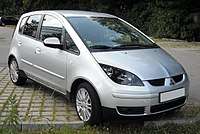
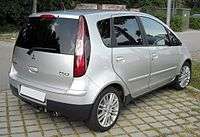
When Mitsubishi introduced a new independent generation of Lancer in 2000 (without a corresponding Mirage), the old Mirage-based sedan was discontinued in Japan, although production continued for export. The next phase in the Mirage's demise was the release of the Colt—a five-door hatchback—in 2002. The Colt replaced the Mirage hatchback, despite the latter being a three-door. Unlike its predecessor, the Colt featured a tall, upright design with a short engine compartment to maximize interior dimensions. Engines for the Colt comprised 1.1-liter three-cylinder, plus 1.3-, 1.5-, and 1.6-liter gasoline inline-fours with a standard five-speed manual and optional continuously variable transmission (automatic).
Sales in export markets did not occur until 2004, with production in Japan no longer being the primary source. European models were instead sourced from Born, the Netherlands with a three-door body produced exclusively at this factory from 2004. Also in 2004, the Colt Plus was launched as a longer version of the standard five-door with greater luggage capacity. Then in 2006, the range expanded further with the release of the Colt CZC—a convertible with a retractable hardtop roof. Colt convertibles were produced only at the Netherlands facility, with final assembly taking part with Pininfarina at Turin, Italy.
Manufacture of the Colt ended in 2012, with the successor model reverting to the Mirage name internationally. Unlike the Colt's expensive architecture shared with the Smart Forfour, the emphasis on the Mirage is low pricing to increase Mitsubishi's presence in emerging markets.
Sixth generation (A00/LA, A10; 2012)
| Sixth generation (A00/A10/LA) | |
|---|---|
_ES_hatchback_(2018-11-02)_01.jpg) | |
| Overview | |
| Also called |
|
| Production | April 2012 – present (hatchback) June 2013 – present (sedan) |
| Assembly |
|
| Designer | Hideyasu Nakagami (2010)[55] |
| Body and chassis | |
| Body style | 4-door sedan 5-door hatchback |
| Layout | Front-engine, front-wheel-drive |
| Powertrain | |
| Engine | 1.0 L 3A90 I3 (gasoline) 1.2 L 3A92 I3 (gasoline) |
| Transmission | 5-speed Mitsubishi F5MDB manual Jatco JF015E (CVT-7) CVT |
| Dimensions | |
| Wheelbase | Hatchback: 2,450 mm (96.5 in) Sedan: 2,550 mm (100.4 in) |
| Length | Hatchback: 3,710 mm (146.1 in) (pre-facelift) 3,845 mm (151.4 in) (facelift) Sedan: 4,245 mm (167.1 in) 4,305 mm (169.5 in) (facelift) |
| Width | Hatchback: 1,665 mm (65.6 in) Sedan: 1,670 mm (65.7 in) |
| Height | Hatchback: 1,490 mm (58.7 in) Sedan: 1,515 mm (59.6 in) |
| Curb weight | 905–940 kg (1,995–2,072 lb) |
| Chronology | |
| Predecessor | Mitsubishi Colt |
_ES_hatchback_(2018-11-02)_02.jpg)
_interior.jpg)
The Colt was renamed back to Mirage in 2012. The sixth generation was previewed as a concept car at the 2011 Geneva Auto Show, with series production cars unveiled at the 2011 Tokyo Motor Show. For some European markets, the name Mitsubishi Space Star is used.[56]
The Mirage is built at Mitsubishi Thailand's Laem Chabang plant, facility number three since 19 April 2012.[57][58][59] The car is mainly developed as a response to the Eco Car policy endorsed by the Thailand government.[60] The car effectively doubled Mitsubishi sales figures in the country.[61] Shipments to Japan began in July, with the Australian hitting the market in January 2013.[62] Mitsubishi Motors Philippines began manufacturing both the hatchback and G4 sedan variants of the Mirage for the country's market in January 2017.[54]
In designing the Mirage, Mitsubishi's objectives were affordability (including in developing economies) and high efficiency.[63] To aid efficiency, minimizing vehicle mass was one engineering focus. "Painstaking efforts to reduce weight", including the use of high-tensile steel in the body,[63] resulted in a vehicle that is the lightest in its segment in some markets.[64][65] In North America, it is the lightest 4-door car available (only the 2-passenger Smart Fortwo is lighter).[66]
Reducing aerodynamic drag was another primary design goal. One of the car's aerodynamic features resulted in a new patent application.[67] The result is the lowest drag coefficient (Cd) in its class.[64] Depending on drivetrain and options, the car's Cd ranges from 0.27 to 0.31.[68]
ASEAN NCAP test results for a right-hand-drive, five-door hatchback variant on a 2013 registration:[69]
| Test | Score |
| Adult occupant protection: | |
| Child occupant protection: | 43% |
- Market
Early Japanese model includes 1.0-liter 3-cylinder engine with Auto Stop & Go (AS&G), CVT and 165/65 R14 tires.[70][71] The 1.0-liter three-cylinder car for the Japanese market achieves 27.2 km/l (64 miles per US gallon) in the JC08 cycle and will have a sub-1 million yen price tag.[72]
The Thai market model was unveiled at the 2012 Bangkok International Motor Show.[73] Thailand model was unveiled on 28 March 2012.[74] The Thai model features the 1.2-liter three-cylinder engine with start-stop, fitted with a CVT or manual transmission.[75]
In the Philippines, the Mirage was introduced in mid-2012 in four different variants, GLX (base) and GLS (top) spec levels both available with either five-speed manual transmission or CVT. All models are powered by the 1.2-liter engine. In late 2013, the sedan version called G4 was added to the lineup, also available in the same four variants as the hatchback. In its first full year of sales (2013), the Mirage reached a place as the sixth best selling car in the country and the best selling hatchback.[76] The refreshed Mirage launched in the country in April 2016.[77]
The North American edition was unveiled at the 2013 Salon International de l'auto de Montreal.[78] Despite previous speculation, the car will be marketed as Mirage in the United States and Canada for the 2014 model year.[79] Canada/U.S. models include 1.2-litre three-cylinder MIVEC engine, five-speed manual transmission or CVT, choice of eight body colors (Kiwi Green, Thunder Gray, Sapphire Blue, InfraRed, Cloud White, Starlight Silver, Plasma Purple and Mystic Black). There was no 2016 model year in the North American market.
- First facelift
At the 2015 LA Auto Show, Mitsubishi previewed the Mirage's 2017 facelift. The car received a new front end design, projector headlights with LED daytime running lights, and LED taillights. The facelift results in a drag coefficient of 0.27cd. In addition, engine output was increased from 74 to 78 hp, the suspension was improved through better shock absorbers, revised spring rates, and uprated brakes (larger discs on front, drums on rear, and different friction material). The interior will also see numerous aesthetic changes from the steering wheel to the HVAC system and a new optional touchscreen infotainment system using Apple's CarPlay interface and a 300W Rockford Fosgate audio setup.[80]
_ES_hatchback_(2018-04-24)_01.jpg) Mitsubishi Mirage ES hatchback (Australia; first facelift)
Mitsubishi Mirage ES hatchback (Australia; first facelift)_ES_hatchback_(2018-04-24)_02.jpg) Mitsubishi Mirage ES hatchback (Australia; first facelift)
Mitsubishi Mirage ES hatchback (Australia; first facelift)
- Second facelift
The second facelift Mirage was launched in Thailand on 18 November 2019, adding safety features such as forward collision mitigation system, radar sensing forward mitigation along with cruise control buttons on the steering wheel. Its bumper design has been revised to bear the design language of its other Mitsubishi models together with a projector headlamp with DRL and LED inlets for the tail-lamps.[81] The updated Mirage will debut in North America in early 2021 as a 2021 model.[82]
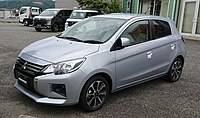 Mitsubishi Mirage M (Japan; second facelift)
Mitsubishi Mirage M (Japan; second facelift).jpg) Mitsubishi Mirage GLS (Thailand; second facelift)
Mitsubishi Mirage GLS (Thailand; second facelift)
- Reception
The current Mirage has proven to be a polarizing design. It has been met with negative reviews in some markets, and praise in others. Favorable reviews highlight the efficiency of the design, while critics often illustrate the car's shortcomings, with a tendency to compare the Mirage with more expensive cars.
Auto Express and Ollie Kew of Car Magazine all gave the car a two out of five star rating.[83][84] Peter Anderson of The Motor Report gave it two-and-a-half out of five stars.[85] What Car? magazine rated the Mirage 3 out of 5 stars for "cost and verdict."[86] Matt Jones of Top Gear magazine gave the Mirage an Overall Verdict of 3 out of 10.[87] Sam Wollaston of The Guardian gave the car a Cool Factor rating of 3 out of 10.[88] Consumer Reports placed the Mirage among the 10 Worst Cars of 2013[89] and Top Gear magazine placed the Mirage on its list of "The worst cars you can buy right now."[90]
Jason Torchinsky of Jalopnik gave the 2014 Mirage an 8 out of 10 for Value[91] and even went on to criticize critics of the Mirage for excessive criticism, saying "I get the appeal of writing a bad review — they're a hell of a lot more fun to write than a good review. ... But you have to keep that critic-lust in check, sometimes, and try and really get to the truth of things."[92]
On the positive side, Kelley Blue Book gave the Mirage an overall rating of 6.2 (with a Consumer Rating of 9.4/10), quoting that "If the most important thing to you is getting the cheapest new car you can find with the most equipment and best possible fuel economy, you'll like the 2015 Mitsubishi Mirage."[93] The Mirage was named one of Forbes magazine's 12 Greenest Cars of 2014, and was one of two non-hybrid vehicles on the list.[94] In the Philippines, the Mirage was awarded the "2012–2013 Car of the Year" by the Car Awards Group.[95] Top Gear Philippines rated the car 18 out of 20, and stated, "For the single person or young couple on a budget, the Mirage is still the sweetest deal in town."[96] In Denmark, the Space Star received largely positive reviews,[97] and was the fifth most sold car in January–February 2015.[98] The Hispanic Motor Press awarded the Mirage as Best Subcompact in 2014[99] and recognized the Mirage G4 as Best Subcompact in 2017. Company Vehicle of New Zealand praises the Mirage, calling it “an ideal city commuter which is absolutely effortless to slip into even the tightest of parking spaces”.[100] The Automotive Science Group has recognized the Mirage for Best All-Around Performance and Best Economic Performance.[101] Patrick Rall of Torque News praised the 2018 Mirage GT, noting it as a "great winter commuter car" with "lots of features".[102] Brian Wong of Cars.com called the Mirage GT "fun to drive" and praised its light-weight design.[103] Erik Shilling notes that after eight years on the market, "the Mirage is probably the best kind of car there is: a cheap car that functions, and isn’t pretending otherwise."[104]
| Type/code | Power, torque at rpm |
|---|---|
| 1,193 cc (72.8 cu in) I3 (DOHC MIVEC 3A92) | 78 PS (57 kW; 77 hp) at 6,000, 10.2 kg⋅m (100 N⋅m; 74 lbf⋅ft) at 4,000 |
| 1.0 L I3 (DOHC MIVEC 3A90) | 69 PS (51 kW; 68 hp) at 6,000, 8.8 kg⋅m (86 N⋅m; 64 lbf⋅ft) at 5,000 |
Sedan (A10)
_sedan_(2018-07-19)_01.jpg)
_sedan_(2018-07-19)_02.jpg)
The four-door sedan version of the Mirage, known as Mitsubishi Attrage or Mitsubishi Mirage G4 in some markets, has been manufactured at Mitsubishi's Laem Chabang plant in Thailand since June 2013.[105] While based on the hatchback, the sedan is unique from the back doors rearwards, and has revised front styling. The sedan was first introduced as a concept car at the 2013 Bangkok Auto Show called the Concept G4 sedan.[53][106][107] Like the hatchback, the sedan is offered with a 1.2-liter engine.
According to Masaaki Yamada, senior adviser for Mitsubishi Motors Philippines, the company used the Mirage G4 name in the Philippine market, as they claimed the "Attrage" nameplate has a negative connotation in the Filipino language.[108] "Attrage" sounds too much like atrás, Filipino or Spanish for "going backwards".[108] The Mirage G4 was released in Philippine dealerships in October 2013.[109]
In Mexico, the Attrage is sold as the Dodge Attitude, replacing the Hyundai Accent (RB) from January 2015 model after Hyundai's arrival in the Mexican market.[110]
The Attrage is also sold in a few Western European markets such as Austria, Switzerland, Belgium, Turkey and Luxembourg (until 2018). The engine is available as a 1.2-liter three-cylinder engine that produces 59 kW (80 hp). A continuously variable transmission is available as an option.
For the US market, the Mirage G4 sedan was available from spring 2016 as a 2017 model. It is available in ES and SE trims, with 7 airbags available as standard.[111]
Starting on 1 February 2019, the Mitsubishi Mirage G4 has been sold in Mexico alongside the return of Mitsubishi in the Mexican market.[112]
The Attrage received its facelift in Thailand on 18 November 2019 with the same front fascia as the second facelift Mirage hatchback.[81]
Production and sales
Production
| Year | Thailand | Philippines | Total | ||
|---|---|---|---|---|---|
| Mirage | Attrage | Mirage | Mirage G4 | ||
| 2011 | 20 | - | - | - | 20 |
| 2012 | 122,633 | - | - | - | 122,633 |
| 2013 | 97,938 | 47,006 | - | - | 144,944 |
| 2014 | 100,240 | 29,850 | - | - | 130,090 |
| 2015 | 83,857 | 53,733 | - | - | 137,590 |
| 2016 | 86,189 | 65,329 | - | 1,388 | 152,906 |
| 2017 | 71,927 | 64,033 | 4,633 | 10,475 | 151,068 |
| 2018 | 77,577 | 60,879 | 3,885 | 14,072 | 156,413 |
| Total | 640,381 | 320,830 | 8,518 | 25,935 | 995,664 |
| 961,211 | 34,453 | ||||
(Sources: Facts & Figures 2013, Facts & Figures 2018, Facts & Figures 2019, Mitsubishi Motors website)
Sales
| Year | Mirage (sedan & hatchback) | Mirage Hatchback/Space Star | Attrage/Mirage G4 | Dodge Attitude Sedan | Mirage G4 | |||||
|---|---|---|---|---|---|---|---|---|---|---|
| United States | Canada | Mexico | Europe[113] | Thailand | Philippines | Philippines | Thailand | Mexico | ||
| 2012 | 34 | |||||||||
| 2013 | 2,935[114] | 614 | 13,978 | |||||||
| 2014 | 16,708 | 4,048 | 22,008 | 10,990[115] | 11,722[115] | |||||
| 2015 | 21,515 | 3,361 | 3,552 | 29,547 | 4,290[116] | 5,106 | 8,192 | 11,020[116] | 13,778[117] | |
| 2016 | 22,226 | 3,112 | 4,701[118] | 27,386 | 7,070[119] | 7,346 | 11,888 | 9,005[119] | 20,356[120][121] | |
| 2017 | 22,386[122] | 2,502 | 8,037[123] | 30,016 | 9,585[124] | 20,032 | 13,247[125] | 13,247[124] | ||
| 2018 | 22,568 | 1,570[127] | 5,678[128] | 36,105 | 15,714[129] | 14,763 | 10,371 | 14,892[130] | ||
| 2019 | 26,966 | 2,156[131] | 4,081[132] | 38,002 | 3,015 | 4,316[133][134] | 11,664[135] | 2,754[136] | ||
| SubTotal | 135,304 | 17,363 | 26,049 | 197,076 | 50,664 | 47,247 | 20,080 | 59,685 | 80,123 | 2,754 |
| Total | 636,345 | |||||||||
References
- Mitsubishi Colt Mirage (1978 - 1983), classics.honestjohn.co.uk Retrieved 6 January 2018
- "自動車ガイドブック [Japanese Motor Vehicles Guide Book 1979/1980]" (in Japanese). 26. Japan: Japan Automobile Manufacturers Association. 1 November 1979: 154–156. 053-790026-3400. Cite journal requires
|journal=(help) - Hartford, Bill (June 1978). "Mirage from Mitsubishi". Popular Mechanics. 149 (6): 52. ISSN 0032-4558.
- Auto Katalog 1984. Stuttgart: Vereinigte Motor-Verlage. 1983. pp. 115–116, 226–227.
- Long (2007), p. 36–37.
- Automobile Guide Book 1979/1980, p. 114
- "Mitsubishi Colt 1400". Unique Cars and Parts. Retrieved 23 June 2012.
- Yamaguchi, Jack K. (1979), Lösch, Annamaria (ed.), "The Year of Uncertainty?", World Cars 1979, Pelham, New York: The Automobile Club of Italy/Herald Books: 61–62, ISBN 0-910714-11-8
- Ickx, Pascal (1983-06-02). "Essai détaille: Mitsubishi Lancer F GLX". Le Moniteur de l'Automobile (in French). Vol. 33 no. 770. Brussels, Belgium: Editions Auto-Magazine. p. 113.
- Ickx, p. 120.
- 自動車ガイドブック [Japanese Motor Vehicles Guide Book '82~'83] (in Japanese), 29, Japan: Japan Automobile Manufacturers Association, 1982-10-20, p. 168, 053-820029-3400
- CG Car Archives '80s, p. 207.
- Ickx, p. 119
- CG Car Archives '80s, p. 211
- Automobile Guide Book '82~'83, p. 120
- Hogsten, Dag E. (1982-11-17). "Skjutjärn" [Shooting iron]. Teknikens Värld (in Swedish). Vol. 34 no. 22. Stockholm, Sweden: Specialtidningsförlaget AB. p. 61.
- Automobile Guide Book '82~'83, p. 314
- 自動車ガイドブック [Japanese Motor Vehicles Guide Book 1983-84] (in Japanese), 30, Japan: Japan Automobile Manufacturers Association, 1983-10-28, p. 155, 0053-830030-3400
- Long (2007), p. 38–39.
- Witzenburg, Gary (October 1981). "Driving the 1982 Chryslers". Popular Mechanics. 156 (4): 91. ISSN 0032-4558.
- Flammang, James; Covello, Mike (1 October 2001). Standard Catalog of Imported Cars 1946–2002. Iola, Wisconsin: Krause Publications. pp. 503–504. ISBN 9780873416054.
- Davis, Tony (1987). Aussie Cars. Hurstville, New South Wales: Marque Publishing. p. 165. ISBN 0-947079-01-7.
- Davis, Tony (1990). The New Car Buyers Guide 1990/91 (1st ed.). p. 33.
- The Red Book. Automated Data Services. October 1989. pp. 142–144.
- Gover, Paul (26 August 1988). "Colt should still sell on price". The Canberra Times, Weekend Supplement. p. 5. Retrieved 26 July 2016.
- Ickx, p. 112.
- Büschi, Hans-Ulrich, ed. (1987-03-05). Automobil Revue 1987 (in German and French). 82. Berne, Switzerland: Hallwag AG. p. 398. ISBN 3-444-00458-3.
- Automobil Revue 1987, p. 397
- Mitsubishi Vans (brochure) (in Dutch), Sassenheim, Holland: Hart Nibbrig & Greeve, 1985, pp. 3, 4
- 自動車ガイドブック [Japanese Motor Vehicles Guide Book 1989~'90] (in Japanese), 36, Japan: Japan Automobile Manufacturers Association, 1989-10-25, pp. 187, 255, 0053-890036-3400
- Kurki-Suonio, Hannu (1985-03-19). "Autotieto 1985" [Car specifications 1985]. Tekniikan Maailma (in Finnish). Vol. 41 no. 5/85. Helsinki: TM-Julkaisu. pp. Automaailma 32–33. ISSN 0355-4287.
- Kurki-Suonio, Hannu (1985-03-19). "Jokamiehen formula ykköset" [Everyman's Formula Ones]. Tekniikan Maailma (in Finnish). Vol. 41 no. 5/85. Helsinki: TM-Julkaisu. p. 51. ISSN 0355-4287.
- Kurki-Suonio, p. 59
- Mastrostefano, Raffaele, ed. (1990). Quattroruote: Tutte le Auto del Mondo 1990 (in Italian). Milan: Editoriale Domus. p. 545.
- 自動車ガイドブック [Japanese Motor Vehicles Guide Book 1990~'91] (in Japanese), 37, Japan: Japan Automobile Manufacturers Association, 1990-10-25, p. 144, 0053-900037-3400
- Automobile Guide Book 1990~'91, p. 191
- "1990 Mitsubishi Lancer GL 5-dr hatch". GoAuto. John Mellor. Retrieved 4 November 2010.
- "Mitsubishi Lancer CC Lancer 1992–1996". GoAuto. John Mellor. Retrieved 4 November 2010.
- Anderson, Donn, ed. (April 1993). "Newsline: Changes to Lancer range". New Zealand Car. Auckland, New Zealand: Accent Publishing Cnr. 7 (6): 13. ISSN 0113-0196.
- "Mitsubishi Lancer". JMA Motors. Archived from the original on 11 August 2012.
- "Mitsubishi". JMA Motors. Archived from the original on 28 January 2013.
- "NRMA Car Review – Mitsubishi Lancer CC". NRMA. 2 May 1996. Archived from the original on 18 March 2009. Retrieved 30 December 2008.
- "Mitsubishi Lancer in India – Prices, Reviews & Photos". CarWale. Retrieved 5 February 2014.
Mitsubishi Lancer LXi 1.5 [2005–2010], Mitsubishi Lancer LXd 2.0 [2005–2012]
- "Mitsubishi Motors". mitsubishi-motors.co.in. Archived from the original on 17 October 2012. Retrieved 5 February 2014.
- "MMC suspende su actividad en Venezuela de manera indefinida" (in Spanish). Autoblog Español. 25 August 2009. Archived from the original on 22 February 2014. Retrieved 5 February 2014.
- "Listado de precios" (in Spanish). mitsubishi-motors.com.ve. Archived from the original on 27 December 2010. Retrieved 5 February 2014.
- "Mitsubishi. Mitsubishi in India". Car-cat.com. Retrieved 28 July 2010.
- "2004 Soueast Lioncel specs".
- "2005 Soueast Lioncel specs".
- "Mitsubishi Lancer (China) specs".
- "Soueast V3 Lingyue facelift".
- "Soueast V3 Lingyue range".
- "Mitsubishi's new global compact sedan is called Attrage". Top Gear Philippines. 23 May 2013. Retrieved 29 May 2013.
- "These companies will help Mitsubishi PH build the Mirage locally". Top Gear Philippines.
- "Automobile body".
- (Quattoruote) Mitsubishi Mirage: In Europa si chiamerà Space Star
- "三菱自、タイでエコカー生産開始". Newsclip.be. Retrieved 3 August 2012.
- "Mitsubishi Begins Production of the Mirage in Thailand". Autoevolution.com. 20 April 2012. Retrieved 3 August 2012.
- "Mitsubishi Motors Started Production of the Mirage Line-off Ceremony for the Mirage held in Thailand" (Press release). Mitsubishi-motors.com. 19 April 2012. Retrieved 3 August 2012.
- "Mitsubishi Motors to Launch New Mirage Global Compact in Japan". www.mitsubishi-motors.com. Retrieved 2020-06-21.
- http://www.mitsubishi-motors.com/content/dam/com/ir_en/pdf/fact/2013/fact_2013.pdf
- GoAutoMedia (17 May 2012). "Mitsubishi boosts Mirage production". Goauto.com.au. Retrieved 3 August 2012.
- "PDF: Social and Environmental Report 2012 (p. 14)" (PDF). Mitsubishi Motors Corporation. Retrieved 20 December 2013.
- Batchelor, James. "First drive review: Mitsubishi Mirage". AOL Cars U.K. Retrieved 20 December 2013.
- Campbell, Matt. "New car comparison: Mirage v Alto v Micra v Up". Drive – The Canberra Times. Archived from the original on 20 December 2013. Retrieved 20 December 2013.
- "12 lightest cars in the US, 2014 (vs. Mitsubishi Mirage 1973 lbs curb weight)". MirageForum.com. Retrieved 20 December 2013.
- "News Release: Mitsubishi Mirage – Efficient". Automotive World. Retrieved 20 December 2013.
- "Aerodynamics of the new Mirage (0.27–0.31 drag coefficient varies with options)". MirageForum.com. Retrieved 20 December 2013.
- "Mitsubishi Mirage". ASEAN NCAP. Archived from the original on 6 March 2014. Retrieved 8 May 2014.
- "Your eyes do not deceive, that's the 2012 Mitsubishi Mirage".
- "Mitsubishi rolls out new Mirage alongside Concept PX-MiEV II for Tokyo".
- On, Stephen (19 May 2012). "Mitsubishi Mirage Gets Kei-Car Rivaling 27.2 km / L Fuel Economy". Integrityexports.com. Retrieved 3 August 2012.
- Lim, Anthony. "Mitsubishi Mirage debuts in Bangkok – five variants in all". Paultan.org. Retrieved 3 August 2012.
- "Mitsubishi Motors Corporation Begins Sale of the Mirage in Thailand – JUMP 2013 strategy focusing on emerging markets comes alive -".
- Mitsubishi Motors. "Mitsubishi Mirage 2012 (Full Specifications)". Retrieved 23 April 2012.
- "Mitsubishi Mirage 2016 Launched at Prices Starting From PhP 553,000".
- Mitsubishi Mirage bows in Montreal without a name, Canadian sales promised
- "Mitsubishi unveils 2014 Mirage subcompact". Los Angeles Times. 28 March 2013. Retrieved 29 March 2013.
- Tamayo, Niki (20 November 2015). "Mitsubishi Updates ASX, Mirage at LA Auto Show". Top Gear Philippines. Retrieved 20 November 2015.
- "MITSUBISHI MOTORS launched restyled Mirage and Attrage compact models in Thailand". Mitsubishi Motors. 2019-11-18. Retrieved 2019-11-20.
- https://www.autoblog.com/2020/07/22/mitsubishi-new-updated-outlander-phev-mirage-eclipse-cross/
- "Mitsubishi Mirage". Auto Express. Retrieved 16 July 2013.
- Kew, Ollie (28 May 2013). "Mitsubishi Mirage 1.2 (2013) CAR review". Car Magazine. Retrieved 26 June 2013.
- Anderson, Peter (3 June 2013). "2013 Mitsubishi Mirage Sport Manual Review". The Motor Report. Retrieved 26 June 2013.
- "Mitsubishi Mirage Hatchback Review". What Car?. Retrieved 16 July 2013.
- "Mitsubishi Mirage". Top Gear. 2015-01-13. Retrieved 2018-08-08.
- Wollaston, Sam (29 June 2013). "On the road: Mitsubishi Mirage 3 1.2". The Guardian. Retrieved 16 July 2013.
- Barth, Lisa. "10 Worst Cars of 2013". Consumer Reports. Retrieved 6 June 2014.
- "The Worst Cars You Can Buy Right Now". Top Gear magazine. 9 October 2014. Retrieved 12 October 2014.
- Torchinsky, Jason. "2014 Mitsubishi Mirage: The Jalopnik Review". Jalopnik. Retrieved 2018-02-17.
- Torchinsky, Jason. "This Brutal NYT Mirage Review Is What's Wrong With Cheap Car Reviews". Jalopnik. Retrieved 2018-02-17.
- Buglewicz, Keith (2015). "2015 Mitsubishi Mirage". Kelley Blue Book. Retrieved 26 July 2016.
- Gorzelany, Jim (28 January 2014). "12 Greenest Cars of 2014: Mitsubishi Mirage". Forbes. Retrieved 2 February 2014.
- "Mitsubishi Mirage Is 2012–13 Car of the Year-Philippines". Top Gear Philippines. 4 April 2013. Retrieved 16 July 2013.
- Tamayo, Niki (20 March 2013). "Review: Mitsubishi Mirage GLS MT". Top Gear Philippines. Retrieved 16 July 2013.
- Clauding, Søren (October 2014). "Biltest: Mitsubishi Space Star 1,2 MIVEC Intense. Mere end fundet for de penge" [Car test: Mitsubishi Space Star 1.2 MIVEC Intense. More than found for the money]. Motorsiden (in Danish). Retrieved 26 July 2016.
- "De Danske bilimportører: statistik" [The Danish car importers: statistics] (in Danish). De Danske Bilimportører. Archived from the original on 8 May 2013. Retrieved 26 July 2016.
- "Hispanic Motor Press Awards". www.hispanicmotorpressawards.com. Retrieved 2018-02-17.
- "2016 Mitsubishi Mirage - Video Road Report". Company Vehicle Magazine. 7 November 2016. Retrieved 17 February 2018.
- Group, Automotive Science. "2017 MITSUBISHI MIRAGE". Automotive Science Group. Retrieved 2018-02-17.
- "5 Reasons Why the 2018 Mitsubishi Mirage GT is a Great Winter Commuter Car | Torque News". Torque News. 2018-02-16. Retrieved 2018-03-03.
- Wong, Brian (February 28, 2018). "Are We Imagining Things, or Is the Mitsubishi Mirage GT Fun to Drive?". Cars.com. Retrieved March 3, 2018.
- Shilling, Erik (July 16, 2020). "The Case For The Mitsubishi Mirage". Jalopnik.com. Retrieved July 17, 2020.
- "Annual Report 2013" (PDF). Mitsubishi Motors. September 2013. p. 12. Retrieved 22 April 2016.
- Tadeo, Patrick Everett (27 March 2013). "Mitsubishi reveals Concept G4 sedan". Top Gear Philippines. Retrieved 29 May 2013.
- "New Mitsubishi Attrage Sedan Revealed in Depth in Brochure Shots, But Beware; It Ain't Pretty..." Carscoops. 24 May 2013. Retrieved 29 May 2013.
- Sarne, Vernon (30 May 2013). "Attrage won't be the name of Mitsubishi Mirage sedan in PH". Top Gear Philippines. Retrieved 4 September 2013.
- Tadeo, Patrick Everett (3 September 2013). "Want to Know How Much Mitsubishi PH is Selling the Mirage G4?". Top Gear Philippines. Retrieved 23 November 2013.
- Panait, Mircea (30 January 2015). "2015 Dodge Attitude is a Reskinned Mitsubishi Mirage, Sold Only in Mexico – Photo Gallery". Autoevolution. Retrieved 30 January 2015.
- "2017 Mitsubishi Mirage G4". Mitsubishi Motors.
- García, Gerardo (1 February 2019). "Mitsubishi se separa de FCA en México: estos modelos venderá ahora". Motorpasion México. Retrieved 1 February 2019.
- "Mitsubishi Space Star European sales figures". carsalesbase.com. Retrieved 2019-11-19.
- Good Car Bad Car (Mitsubishi Mirage Sales Figures Usa Canada)
- "Thailand cars sales report 2014". HeadlightMag.com. Thailand. Archived from the original on 24 October 2018. Retrieved 24 Oct 2018.
- "Thailand cars sales report 2015". HeadlightMag.com. Thailand. Archived from the original on 24 October 2018. Retrieved 24 Oct 2018.
- Motorpasion (Los 20 autos más Vendidos del 2015)
- FCA México (FCA México Reporta)
- "Thailand cars sales report 2016". HeadlightMag.com. Thailand. Archived from the original on 24 October 2018. Retrieved 24 Oct 2018.
- Motorpasion (Los 22 Autos más Vendidos en México Durante 2016 un Año Record para la Industria)
- Auto Dato (Los 100 Coches más Vendidos en México en 2016)
- Good Car Bad Car (Mitsubishi Mirage Sales Figures USA-Canada)
- FCA México (FCA-México Reporta un Crecimiento en ventas del 11% en Julio 2017)
- "Thailand cars sales report 2017". HeadlightMag.com. Thailand. Archived from the original on 24 October 2018. Retrieved 24 Oct 2018.
- Autonocion (Así fueron las ventas de vehículos nuevos en Tailandia durante noviembre: Es uno de los mercados más importantes de Asia)
- FCA Mexico (FCA-México-reporta-ventas-de-8,488-unidades)
- Good Car Bad Car (mitsubishi-mirage-sales-figures-usa-canada)
- Auto Dato (Estos fueron los 85 modelos más vendidos en México hasta octubreLeer completo: Autodato)
- "Sales Report". HeadLight Magazine (in Thai). 2019-05-09. Retrieved 2019-11-19.
- Auto Dato (Asi Cerraron las Ventas de Automoviles Nuevos en México el mes de Noviembre 2018)
- Good Car Bad Car (mitsubishi-mirage-sales-figures-usa-canada)
- Auto Dato ( Ventas octubre 2019, México: Continúan las cifras negativas)
- Headligtmag (Sales Enero-Marzo 2019)
- Headligtmag (Sales Abril 2019)
- [http s://www.inegi.org.mx/datosprimarios/iavl/ Inegi (Datos Primarios)]
- Motorpasión (Los 374 autos más vendidos en México en 2019)
Bibliography
- Long, Brian (2007). Mitsubishi Lancer Evo: The Road Car & WRC Story. Dorchester: Veloce Publishing. ISBN 1-84584-055-0.
External links
| Wikimedia Commons has media related to |
- Mitsubishi pages: Mirage, Attrage
- Mitsubishi Mirage U.S.website
- Mitsubishi Mirage G4 U.S.website
- Mitsubishi web museum pages: 1978, 1983, 1985 Mirage/Lancer wagon, 1987, 1991, 1995, 1999 Dingo
- Gazoo pages: 1st gen, 2nd gen, 3rd gen, 4th gen, 5th gen